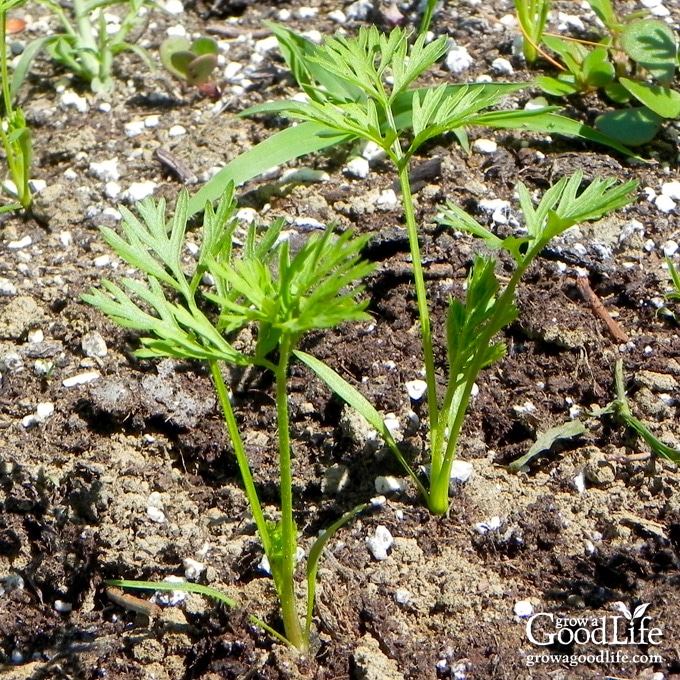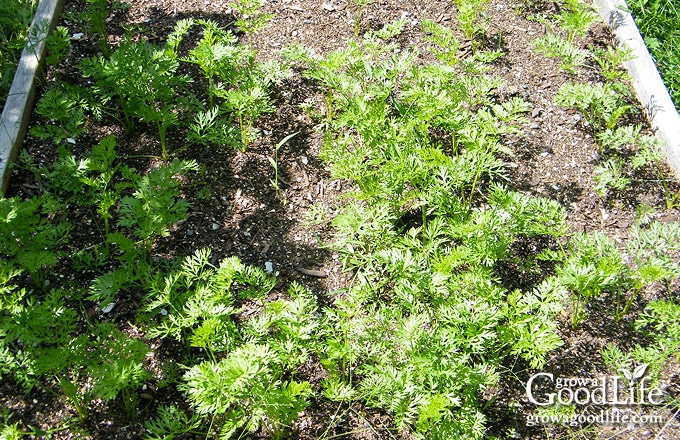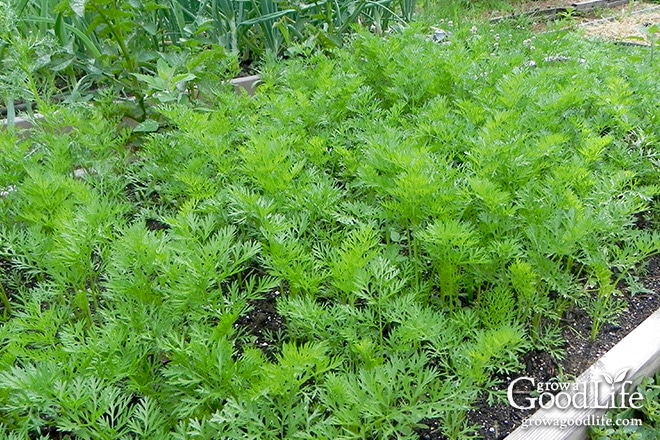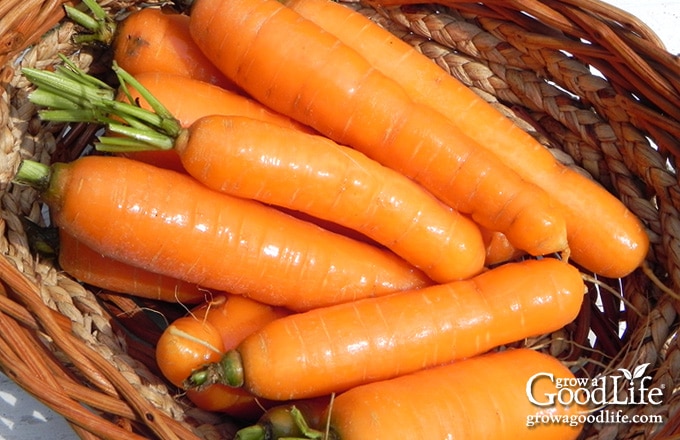Tips for Germinating Carrots
This post may contain affiliate links, which means that I may receive a commission if you make a purchase using these links. As an Amazon Associate I earn from qualifying purchases.
Do you have a hard time growing carrots in your vegetable garden? Getting carrot seeds to sprout can be challenging. Learn how to troubleshoot problems germinating carrots with these tips.
Carrots are one of the most common vegetables that people grow in their gardens. Still, they can be difficult to germinate in certain environments. This is why so many people think carrots are so hard to grow. However, with a little bit of know-how, carrots can be grown easily and provide a delicious addition to your garden.

Many longtime readers of this website will know that I used to have a difficult time growing spring carrots. Fall carrots were rarely a problem. The seeds usually germinate easily and quickly in warmer soil. Once the plants become established, they are likely to succeed, and mature for a fall harvest with little effort on my part other than some weeding and watering.
Spring carrots were another matter. Germination took forever in the spring due to the cool air and soil temperatures. They also often germinated over a period of several weeks in spotty unevenly patches instead of the full bed. I was so frustrated.

After doing some research on troubleshooting problems growing carrots, I realized that getting the seeds to sprout in cool soil, and keeping the young carrot seedlings alive once they do germinate was probably the majority of the issues I had with growing spring carrots.
I suspected my failure growing spring carrots was due to several issues, including cool soil, damping off, crusty soil, and inconsistent moisture. Once I solved those problems, I could grow spring carrots. Here is what I have learned over the years on dealing with problems germinating carrots:
Why Are My Carrot Seeds Not Germinating?
Few vegetables are as misunderstood as carrots. People think they are hard to grow, but once the seeds sprout, carrots are one of the easiest vegetables to grow. The challenge is germinating the seeds.
Since carrots are a cool season crop that can tolerate light frosts, you would think that planting seeds in early spring would be trouble free. However, there are problems that can prevent your seeds from developing, and getting off to a good start.
If you’re having trouble getting your carrot seeds to germinate, there are a few things you can do to troubleshoot. First, set yourself up for success by following the tips in this article on how to grow carrots, and then take special care when sowing early spring carrots with these tips.
Here are common issues you may encounter germinating carrot seeds, and solutions to get around these problems:
Using Old Seeds
Carrot seeds remain viable for up to 3-years, depending on how they are stored. But, the germination rate goes down with age. If you want to give your spring crop the greatest chance at germinating, purchase fresh seeds each year from a reliable source.
Unsuitable Temperature
Carrot seeds sprout best when the soil temperature is between 55˚ to 65˚F. Seeds will germinate as low as 40˚F, but at a much slower rate. Avoid planting your carrots in soil exceeding 75˚F, as high temperatures results in poor germination.
For spring planting, you can sow your carrot seeds once the soil temperature has warmed to at least 40˚F, and about 2 to 3 weeks prior to your last frost date. However, if you wait until the soil is warmer, your seeds will sprout quicker.
Poor Soil Condition
Soil that is heavy can prevent seeds from germinating. Seeds need air and moisture to sprout. Soil that is compressed can prevent moisture from soaking into air pockets, making it difficult for new seeds to get the moisture they need to sprout. Heavy clay soil can also hold on to too much moisture, which can cause the seed to rot instead of sprout.
Carrots germinate and grow their best in a light, loamy soil high in organic matter. A loose soil that is evenly moist is the best way to ensure successful seed germination.
If your native soil is heavy with a lot of clay, amend your carrot bed with sifted finished compost, loosen the soil about 12-inches deep with a digging fork, and rake the surface smooth before sowing seeds. In addition, consider growing carrot varieties like Danvers or Red Cored Chantenay as these types grow well in heavier soil.

Crusty Soil Surface
The soil surface can become compact from rain and sun, and form a hard shell on the surface. This sheds water instead of soaking in, preventing moisture from reaching the seeds. The crust also stops the sprouts from breaking through the soil surface.
One way to prevent crusty soil is to sow radishes mixed in with the carrots. The radishes will sprout first and help break up the soil as they grow. If you harvest the radishes as they mature, they will not interfere with the carrots’ development.
Other ways to prevent the soil from crusting is to scratch the soil lightly around the plants and gently water the soil, or cover the seeds with a light layer of sand or vermiculite to prevent the soil from hardening.
Inconsistent Moisture
Carrot seeds need evenly damp soil to germinate. Once the seeds sprout, their roots are so shallow that they can quickly overheat and die from lack of water.
Water the bed deeply before sowing seeds, and then water with a fine mist twice a day after planting to keep the soil evenly moist. Lightly spray the beds with a watering wand, or watering can with a sprinkling rose, so you don’t flood or dislodge the seeds.
Continue watering once the seeds sprout to ensure the shallow roots have enough moisture. When the plants become established, and develop their several true leaves, you can reduce watering to once a week.
Planting Seeds Too Deep
Seeds contain a limited amount of nutrients to supply energy as the seed germinates and grows. Seeds that are planted too deep will struggle to reach the soil surface. If the spout doesn’t emerge from the soil and receive light, it will run out of nutrients, and die. If the sprout does manage to break through, the struggle may weaken the seedling.
Sow carrot seeds about 1/2 inch deep. You want to sow carrots deep enough to cover and hold in moisture, but shallow enough so the sprout can reach the soil surface quickly to be nourished by the sun.
As long as you keep soil relatively damp, it is better to sow seeds too shallow than too deep. Gently cover the seeds, firm the soil, and water with a gentle sprinkle. Try not to compress the soil over the seeds as you sow them. The soil should be firm enough to hold in moisture, but not so compacted that the seedling can’t break through.
Not Enough Time
Carrot seeds are notoriously slow to spout. Carrot germination time can be anywhere from 1 to 3 weeks depending on the temperature and moisture levels. They also often germinate unevenly over a period of several weeks. Allow plenty of time for germination.
Keep the soil surface moist during that time, and try to be patient. Carrot seeds have a thick seed coat. It takes time for the seeds to absorb enough moisture to penetrate this coating and trigger the seed to sprout.
Damping Off Disease
In spite of all the preparations you made prior to planting carrots, sometimes the seedlings sprout and then just flop over and die. Damping off is a fungal disease that affects growing plants, and can be caused by a number of different pathogens that live in the soil.
Carrots that are infected with damping off disease often fall over and die soon after emerging. The stems usually have a dark, shriveled portion at the soil line. Seeds or newly emerged seedlings are particularly vulnerable to damping off disease when grown in cool and moist soil that is common for springtime.
One of the best defenses against damping off is to avoid giving it the growing conditions it needs. It shouldn’t be a big problem if you grow your carrots in a sunny location with loose well draining soil.
When planting seeds, instead of covering the seeds with garden soil, consider using organic, sterile potting mix and water. Keep your plants well watered but not soggy, and practice good sanitation by removing weeds and dead plants promptly.

I hope these tips help you to overcome any problems germinating carrots that you are experiencing, and soon you will be able to enjoy fresh carrots from your very own vegetable garden!
I have the greatest success germinating carrots when I use homemade seed mats covered with sterile potting mix instead of soil. The fresh potting mix provides several solutions including preventing the soil from crusting, reducing the pathogens that can cause damping off, and helps retain moisture.
Temperature and moisture are two of the key factors in improving carrot seed germination. Being patient is also necessary because unlike most garden seeds, carrots do take several weeks to sprout.

You May Also Like:
- 9 Crops to Grow for Food Storage
- Troubleshooting Seed Starting Problems
- How to Direct Sow Seeds in the Garden
- How to Grow Carrots
Good planning is key to a successful vegetable garden
Whether you are new to growing your own food or have been growing a vegetable garden for years, you will benefit from some planning each year. You will find everything you need to organize and plan your vegetable garden in my PDF eBook, Grow a Good Life Guide to Planning Your Vegetable Garden.


paper towel & toilet paper rolls work great as collars. just slice them up to desired height.
Maggy, What a fantastic idea! Thank you for sharing this tip with us!
Hi I also have problem with getting good germination/ survival rate for early carrots I now plant pregerminated seed (germinated indoors on a saucer covered in wet tissue paper and all popped into plastic bag) into cardboard inners from toilet rolls (I save these up all year) then follow a regieme similar to yours to get them established, it’s a bit of a bind but we like carrots
Nigel, I pre-sprout many seeds, but have never tried carrots. This is a great tip! Thanks for sharing.
Hi Rachel, I’ve grown carrots successfully, but they don’t get as large as what I find at the grocery store or at farmers markets. My largest ones are only 7-8 inches long, and no more than 1 inch diameter at the fattest part. If I leave them in the ground longer, they split. I’ve been told to make the soil more fertile, but when I do they that, they just get hairier, not larger. Any thoughts? How large do yours grow?
Janet, It could depend on the variety of carrots you are growing. What have you tried? Some carrots don’t grow more than 8-inches and some will continue to grow as long as they are in the ground. I had great success last year growing Yaya carrots that were planted in spring and harvested in early September. Yaya is a Nantes type of carrot that typically doesn’t grow larger than 8-inches. Other Nantes varieties I have grown are Scarlet Nantes, Bolero, and Nelson. Nantes type carrots grow very well in my heavier, clay soil.
If you have nice, fluffy soil with little rocks or stones then consider an Imperator variety. These grow about 10-inches long: Sugarsnax is one I tried last year. It didn’t grow consistently though. I had a lot of variations in size and thickness.
Would you mind sharing what kind of carrots you planted or brand
Amy, I grew Yaya and Scarlet Nantes from Fedco (http://www.fedcoseeds.com/seeds/?page=0&cat=Carrots) last spring with great success. I have also grown Mokum, Sugarsnax, Napoli in the past but mostly as fall carrots. I need to experiment more to see how they do with this spring planting method. Danvers is a good carrot to grow too if you have heavy clay soil.
Your carrots look great now! I’ve never tried to grow a fall crop, think I’ll try this year!
Your carrots look amazing! I too have had carrot problems – last year that meant no carrots at all but I think my issues were more to do with some sort of critter eating up the seedlings – either slugs or earwigs – never really figured out which one 🙁
I have the same problem, I could not get carrots to germinate in spring, no problem for fall plant carrots, next year I’ll copy your method and hope for it’ll work for me as well.
Daphne, I like seed mats for spacing. This time it seemed to work out ok since germination was successful. I didn’t think of cutworms, but I don’t seem to have a big problem with them this year since I let the chickens work through the garden before planting.
It looks great. And I’ve found what works for one person, doesn’t always work for another. I tried seed mats, but they seemed to make matters worse for me. Now I use doubled over remay now to keep the soil moist and prevent it from crusting. One of my worst spring problems is cutworms. They aren’t around now when I’m seeding my fall carrots, but in the late spring they just mow the poor things down. And you can’t collar them like you can for a tomato plant.
Congratulations, it looks like your strategies and attention have paid off. Isn’t it amazing how much specialized knowledge we acquire as we stumble our way through the seasons every year.
Michelle, Carrots seem so easy for most. I was determined to figure it out this year. I am so excited that they are growing and healthy.